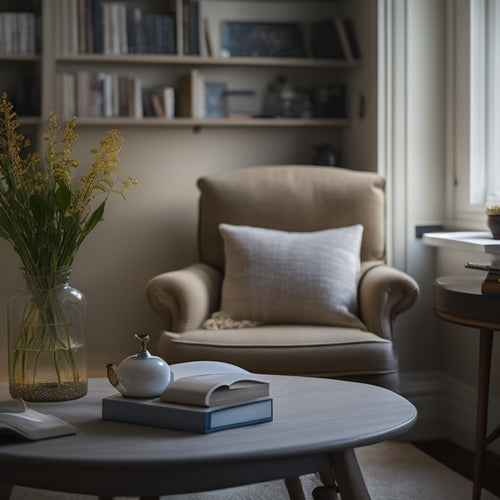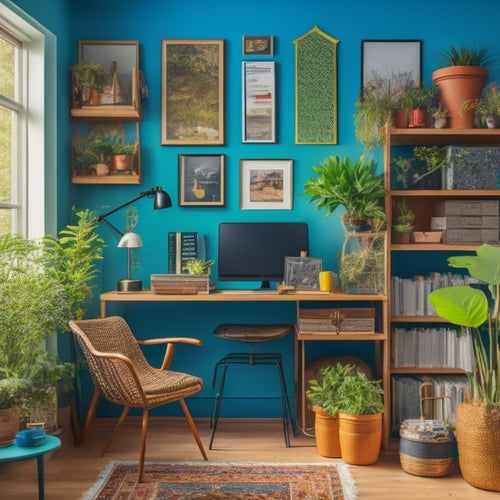
What's Holding You Back From a Clutter-Free Living Room?
Share
You're stuck in a cluttered living room, feeling overwhelmed, and unsure why you can't seem to break free. It's likely one of several common hurdles is standing in your way. Perhaps emotional attachment to sentimental items is making it hard for you to let go, or maybe your room's layout is wasting valuable storage space. You might be struggling with ineffective decluttering strategies, inadequate time management, or unrealistically high expectations. Whatever the reason, identifying the root cause is the first step towards a clutter-free living room. As you explore these potential obstacles, you'll uncover the solutions that will finally set you free.
Key Takeaways
• Emotional attachment to items and fear of letting go hold you back from achieving a clutter-free living room.
• Poor design and utilization of storage space, such as hidden corners and inadequate furniture placement, contribute to clutter.
• Inadequate decluttering strategies, including lacking clear goals and inconsistent effort, hinder progress towards a clutter-free space.
• Insufficient time management and unrealistic expectations of perfectionism create obstacles to achieving an organized living room.
• Ineffective use of vertical space and poor daily maintenance habits, such as neglecting tidying up, prevent a clutter-free living room.
Emotional Attachment to Clutter
You often hold onto clutter because of the emotional attachment you've formed with certain items, making it challenging to let them go. These sentimental items may hold memories of special events, people, or experiences, and the thought of parting with them can be overwhelming. However, keeping clutter can hinder you from achieving a clutter-free living room.
To overcome emotional attachment, start by acknowledging the emotions connected to each item. Ask yourself if keeping the item truly honors the memory or if it's just holding you back. Consider taking a photo of the item and letting it go, or keeping a small portion of it, like a button or a piece of fabric. This way, you'll preserve the memory without the clutter.
In the decluttering process, it's crucial to prioritize organizing tips that work for you. Create a 'maybe' box for items you're unsure about, and set a deadline to revisit the item. If you haven't used or thought about it by then, it's likely safe to let it go. By releasing emotional attachment, you'll be one step closer to a clutter-free living room that brings you peace and joy.
Lack of Storage Space Design
You're likely no stranger to the frustration of feeling like your living room is bursting at the seams, even when you've gotten rid of items you no longer need.
The truth is, you mightn't be making the most of your space. By rethinking your design and making a few strategic tweaks, you can turn hidden corners and awkward areas into functional storage solutions that keep your room feeling calm and clutter-free.
Hidden Corners Wasted Space
Every home has them - those pesky, hard-to-reach areas that seem to swallow up valuable storage space, leaving clutter to accumulate in other areas of the room. These hidden corners can be frustrating, but they don't have to be a storage dead zone. You can turn them into functional spaces with a little creativity.
Consider utilizing overlooked spaces like the area above your doorframe or the narrow gap between your wall and bookshelf. You can install shelves, hooks, or a storage unit specifically designed for these areas. For example, a sliding storage unit can fit snugly into that narrow gap, providing a convenient spot to stash books, decorative items, or even linens.
Get creative with storage solutions that maximize these hidden corners. Look for furniture pieces with built-in storage, like an ottoman with a storage compartment or a coffee table with a lift-top storage bin. You can also repurpose items like wicker baskets, crates, or even old suitcases to create unique storage solutions.
Optimizing Furniture Placement
Rethink the layout of your furniture to uncover hidden storage opportunities, as a well-planned arrangement can make a significant difference in reducing clutter and creating a sense of calm in your living room.
A functional layout is key to maximizing your space. Consider the flow of traffic in your room and place furniture in a way that creates a clear path. This will help you avoid cluttered areas and make the most of your available space.
Next, think about the purpose of each piece of furniture. Do you really need that coffee table, or can you replace it with a storage ottoman? Look for multi-functional pieces that serve more than one purpose. A stylish arrangement doesn't have to mean sacrificing storage.
In fact, a well-designed room can be both beautiful and functional. By optimizing your furniture placement, you can create a clutter-free living room that's both relaxing and inviting.
Take the time to assess your furniture layout and make intentional decisions about the pieces you keep and how you arrange them. The result will be a space that feels calm, organized, and beautiful.
Inadequate Decluttering Strategies
You've probably tried to declutter your living room before, but it's likely that you didn't quite get the results you wanted.
That's because you might've been missing an important element: a clear goal for what you want to achieve. Without a specific objective, it's easy to get sidetracked or lose steam, which is why it's necessary to define what clutter-free means to you before you start.
Lacking Clear Goals
Without a clear idea of what you want to achieve, you'll likely find yourself stuck in a cluttered living room, surrounded by piles of items you're unsure what to do with. You might've a vague desire to declutter, but lacking specific goals, you'll struggle to make progress.
To get unstuck, establishing clear goals for your decluttering project is crucial. Here are some key considerations to get you started:
-
Setting priorities: Identify the areas of your living room that bother you the most, and tackle those first.
-
Establishing milestones: Break down your decluttering project into smaller, manageable tasks to help you stay focused and motivated.
-
Visualizing success: Imagine how you want your living room to look and feel when it's clutter-free, and use that vision to drive your efforts.
-
Creating an action plan: Develop a step-by-step plan to achieve your goals, including deadlines and tasks.
-
Tracking progress: Regularly track your progress to stay motivated and see how far you've come.
Inconsistent Effort
Now that you've set clear goals for your decluttering project, it's time to confront the reality that inconsistent effort can quickly derail your progress, leaving you stuck with inadequate decluttering strategies that fail to produce lasting results.
You might start strong, but without a sustained effort, you'll soon find yourself backsliding into old habits. Sporadic motivation and procrastination can be major obstacles to achieving a clutter-free living room.
To overcome this, you need to commit to short-term dedication that yields long-term results. Break down your decluttering project into manageable tasks and schedule them into your daily or weekly routine. This will help you stay focused and avoid burnout.
Insufficient Time for Organizing
Finding a spare moment to tackle clutter can be a challenging task, especially when your daily schedule is already packed with work, family, and social commitments. You're not alone if you feel like you're constantly running on a tight schedule, leaving little time for organizing.
However, effective time management and prioritizing tasks can make a significant difference.
Here are some tips to help you make the most of your limited time:
-
Start small: Break down larger tasks into smaller, manageable chunks, like decluttering one area at a time.
-
Create a schedule: Set aside a specific time each day or week to dedicate to organization and stick to it.
-
Focus on high-impact areas: Identify the most cluttered areas that bother you the most and tackle those first.
-
Use quick decluttering methods: Implement efficiency tips like the 'one-touch rule' or the '5-minute tidy' to maximize your time.
-
Leverage downtime: Use moments like commercial breaks or waiting in line to quickly sort through small areas, like your purse or a drawer.
Unrealistic Expectations of Perfection
You set yourself up for frustration and disappointment when you expect a clutter-free living room to look like a magazine spread or a Pinterest board, with every item perfectly placed and not a single speck of dust in sight. This perfection pressure can be overwhelming, making you feel like you're never good enough.
But here's the truth: nobody's home is perfect, and that's okay. The comparison trap is real, and it's time to break free from it. Instead of comparing your space to others, focus on your personal progress. Celebrate the small wins, like clearing out a single shelf or decluttering a small area.
Fear of Letting Go of Memories
Memories connected to certain items can make it challenging to part with them, even if they no longer serve a purpose in your life. You're not alone in this struggle. Letting go of sentimental items can be a significant hurdle in achieving a clutter-free living room. Recognizing that the memories themselves aren't tied to the physical item is crucial; they're stored in your heart and mind.
Here are some common reasons why you might be holding onto sentimental items:
-
Emotional attachment: You feel a strong emotional bond to the item, and releasing it feels like you're releasing the memory or person associated with it.
-
Fear of forgetting: You're concerned that if you discard the item, you'll forget the memory or person connected to it.
-
Guilt: You feel remorseful about parting with something that was given to you or that holds sentimental value.
-
Sentimental value: You believe the item has intrinsic value simply because it's sentimental.
-
Lack of alternative solutions: You're uncertain about what to do with the item or how to preserve the memory without keeping the physical object.
Ineffective Use of Vertical Space
Vertical space in your living room often goes underutilized, leading to cluttered floors and surfaces that make the space feel cramped and overwhelming. You're not alone in this struggle. Many of us fail to maximize our room's vertical space, resulting in cluttered areas that could be freed up with some clever storage solutions.
To combat this, consider incorporating vertical storage solutions into your space. You can start by utilizing wall shelves to store items like books, decorative pieces, or even plants. This won't only free up floor space but also add visual appeal to your room.
Another great idea is to invest in space-saving furniture, such as a storage ottoman or a console table with built-in shelves. By maximizing your room's height, you'll be able to create a sense of openness and airiness, making the space feel more relaxing and inviting.
Poor Maintenance Habits Daily
Even with clever storage solutions in place, clutter can still creep back in if you don't establish consistent daily habits to maintain your space.
It's easy to get caught up in the hustle and bustle of daily life, but neglecting your daily routines can lead to clutter triggers that negate all your hard work.
To avoid this, incorporate these simple habits into your daily routine:
-
Set aside 10 minutes each morning to tidy up and put away any items that are out of place
-
Designate a 'launching pad' near the entrance of your home where you can place your keys, wallet, and other essentials
-
Make it a habit to put away items after use, such as cleaning supplies, toys, or books
-
Implement a 'one-touch rule' where you deal with items as soon as you touch them, either by putting them away or tossing them
-
Schedule weekly organization sessions to tackle any clutter that's starting to build up
Frequently Asked Questions
How Do I Organize Clutter-Prone Areas Like Coffee Tables and Shelves?
You tackle clutter-prone areas like coffee tables and shelves by implementing clever storage solutions and decluttering tips, then incorporating stylish organization and minimalist design to create a peaceful space that reflects your personal style.
Can I Still Have a Cozy Living Room With Minimal Decorations?
You can absolutely achieve a cozy living room with minimal decorations! Focus on a few statement pieces, simplify the space, and balance minimalist vs. cozy decor to create a warm, inviting atmosphere that feels like home.
What if My Family Members Are Resistant to Decluttering Efforts?
When family members resist decluttering, you're faced with unique challenges. You'll need to find compromises that work for everyone, and motivate them to get on board by explaining the benefits and involving them in the decision-making process.
How Often Should I Deep Clean My Living Room to Maintain Organization?
"Imagine waking up to a peaceful oasis every morning! To maintain organization, you should aim for seasonal cleaning, monthly decluttering, and quick tidy-ups, paired with daily maintenance to keep your living room clutter-free and serene."
Are There Any Decluttering Apps or Tools That Can Help Me Stay on Track?
You're looking for decluttering apps to stay on track! Try Habitica, Declutter, or Spark Joy to organize your space and digital life, embracing minimalist living while tackling digital clutter with these user-friendly organization tools.
Related Posts
-

What's the Secret to Organizing Digital Clutter?
You're tired of feeling overwhelmed by digital mess, wasting time searching for lost files and drowning in a sea of d...
-

Simplify Your Space: Downsizing Tips for Seniors
You're ready to simplify your space and create a more peaceful living environment. Start by gathering boxes, bins, an...
-

3 Best Online Courses for Home Organization Skills
You're just a few clicks away from a clutter-free home and a more efficient daily routine. Three online courses can h...


